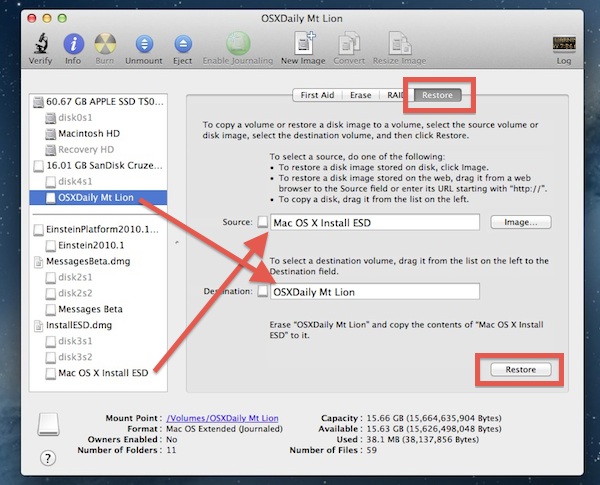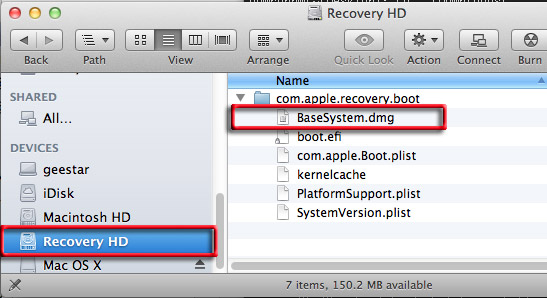Open Dmg From Recovery Boot
macOS Recovery is part of the built-in recovery system of your Mac. You can start up from macOS Recovery and use its utilities to recover from certain software issues or take other actions on your Mac.
How to use macOS Recovery
- Jul 21, 2018 The exception are the Macs that originally shipped with a recovery DVD prior to Lion, or earlier Macs that lack the firmware update to boot into Internet Recovery. On some older Mac’s, Internet recovery is done with key combo shift + option + command ⌘ + r.
- Apr 01, 2018 I Bought a $3 2TB USB Drive and Got More Than Just Malware - Duration: 11:18. Jays Tech Vault Recommended for you.
- Mar 03, 2020 To use the default boot image on the server, hold down Option-N instead. Disabled when using a firmware password. Command-S: Start up in single-user mode. Disabled in macOS Mojave or later, or when using a firmware password. T: Start up in target disk mode. Disabled when using a firmware password. Command-V: Start up in verbose mode.
- Turn on your Mac and immediately press and hold Command (⌘)-R.
- Release the keys when you see an Apple logo, spinning globe, or other startup screen.
- You might be prompted to enter a password, such as a firmware password or the password of a user who is an administrator of this Mac. Enter the requested password to continue.
- Startup is complete when you see the utilities window:
- After starting up from macOS Recovery, select a utility, then click Continue:
- Restore From Time Machine Backup:Restore your Mac from a Time Machine backup.
- Reinstall macOS: Download and reinstall the Mac operating system.
- Get Help Online: Use Safari to browse the web and find help for your Mac. Links to Apple's support website are included. Browser plug-ins and extensions are disabled.
- Disk Utility: Use Disk Utility to repair or erase your startup disk or other storage device.
Additional utilities are available from the Utilities menu in the menu bar: Startup Security Utility (or Firmware Password Utility), Network Utility, and Terminal.
- To quit macOS Recovery, choose Restart or Shut Down from the Apple menu . If you want to choose a different startup disk before quitting, choose Startup Disk from the Apple menu.
If you can't start up from macOS Recovery
If your Mac can't start up from the built-in recovery system, it might automatically try to start up from macOS Recovery over the Internet. When that happens, you see a spinning globe instead of an Apple logo during startup.
To manually start up from macOS Recovery over the Internet, press and hold Option-Command-R or Shift-Option-Command-R at startup. Learn more about these key combinations.
If your Mac still can't start up from macOS Recovery, you might need to start up from another disk or volume, or use a bootable installer.
macOS Recovery over the Internet, the Reinstall macOS utility, and the Get Help Online utility all require an Internet connection. If you need to connect to a Wi-Fi network, move your pointer to the top of the screen, then choose a network from the Wi-Fi menu in the menu bar.
On every OS X Lion installation a hidden partition is created to enable a method for Lion to be reinstalled on the machine, it is known as the recovery partition or drive and is 650mb in size.
If you bought a new machine from Apple you have OS X 10.7 already installed – but no back up disk! and since you haven’t bought the OSX Lion 10.7 App from the App store you can’t re-download it – so thats why you have the recovery drive as a partition in your main hard drive and to boot from it you need to restart the machine holding down “command” + “r” keys.
From recovery mode you can run Disk Utility, get online help and do a restore from a Time Machine backup and re-install Lion leaving all your other files intact – it just replaces the core operating system.
Aug 02, 2011 Make a Bootable USB Drive from OS X Lion Using the Recovery Partition August 2, 2011 19 Comments On every OS X Lion installation a hidden partition is created to enable a method for Lion to be reinstalled on the machine, it is known as the recovery partition or drive and is 650mb in size. My iMac's HD died last week, and so I was unable to access OS X (I had a Time Machine backup of it though). Fortunately I was able to boot into the Recovery HD and use Disk Utility to backup Boot Camp to a DMG file on an external drive before I lost that forever. So, now I have a DMG file containing Windows 7.

You can make a bootable USB drive or disk of the recovery drive, but involves a small trip to the Terminal….
1) Launch Terminal from /Applications/Utilities and run:
The primary drive in this list is No.2 with the “Identifier” of disk0s2, the boot recovery drive is disk0s3
We can also identify the recovery drive by the name and the size – set at 650mb
2) Mount the drive:
Output should be:
Now the Recovery HD is mounted in the Finder and you can see it in the sidebar under Devices
Navigate to it from the sidebar – Recovery HD/com.apple.recovery.boot/BaseSystem.dmg.
3) Doubleclick BaseSystem.dmg to mount it also in the sidebar. This will mount the volume ” Mac OSX Base System”
mac-osx-lion-base-system
4) Open Disk Utility in /Applications/Utilities
5) Put in a 2GB+ USB drive, let Disk Utility load it. The USB drive needs to be formatted as Mac OS Extended Journaled, if its not, its time to format it in Disk Utility…

Open Dmg From Recovery Boot Windows 10
6) Finally in still in Disk Utility, select the “Restore” tab – drag the mounted volume “Mac OSX Base System” into the Source field and drag the USB drive “Volume” (mine is called SuperBootUSBDrive) to the Destination.
restore-volume-osx-usb
Part 1: Open a DMG File in Windows 10/8/7 with PeaZip. PeaZip is a free and open-source file manager for varios types of compressed files. It can be used to open and view archive file formats such as DMG, ISO, RAR and many more. To burn a DMG file, please follow the below steps, 1. Run AnyBurn, then click 'Burn image file to disc'. The 'Burn image file' page will show. You can select the source DMG file by clicking 'Browse' button. The burning drive list will list all writers connected to the computer, please select the correct one from the list if multiple writers are connected. The default burning speed is the maximum speed allowed. Burn dmg windows open source.
7) Click Restore – 25 minutes later – One bootable USB drive
Your bootable USB drive will be called “Mac OS X Base System” after the restore is complete. Now to boot from it just select it as the Start Up disk in System Preferences or hold down option key on boot and select it from the choice of bootable devices.
If you have downloaded the Lion App from the App Store then you can also make a boot disk/drive from this, guide is here, you need to make the boot drive/disk before you install the Lion App, as the installer is deleted after running it. Thats why the guide here can get you out of trouble.
Open Dmg From Recovery Boot Mac
Couple of footnotes on this – Apple has released a knowledgebase article about the recovery partition, also just released from Apple is an app that will do the same as above.
Update For Newer Models – hidden BaseSystem.dmg
If you have the latest models from Apple that came already shipped with OSX 10.7, then you may not have the “BaseSystem.dmg” but instead see a “BaseSystem.chunklist” , the “BaseSystem.dmg” is there it’s just hidden.
To show it so you can see it in the finder – go to Terminal – enter:
Now it will be visible in the Finder.